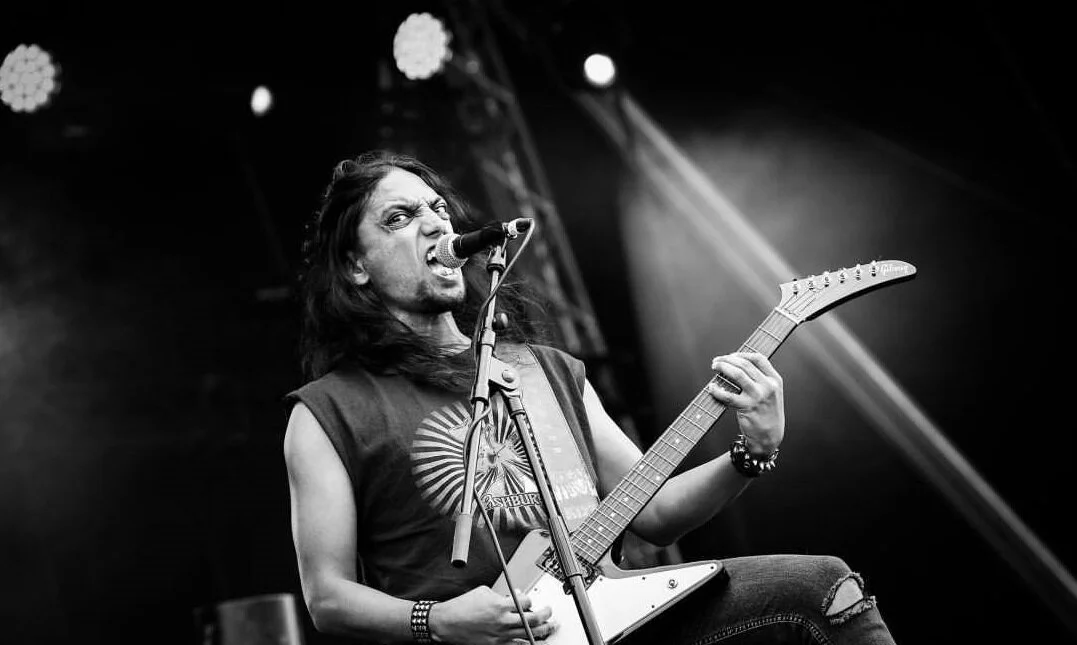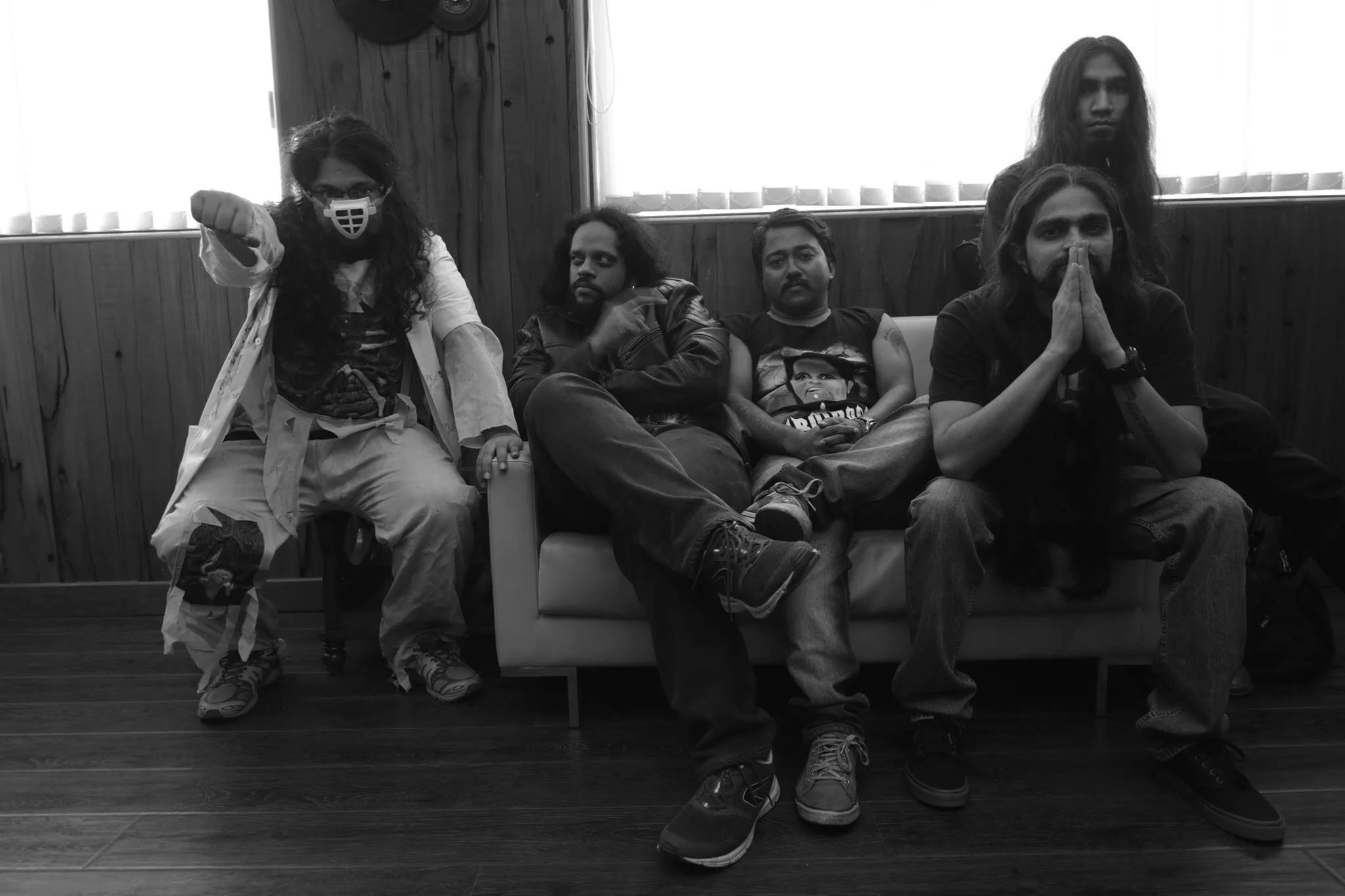Livin’ With Metal: A peep into the Indian metal scene
Nolan Lewis of Kryptos. Image courtesy: Kryptos
To provide a glimpse of India’s metal scene, Nidhi Lodaya interviewed some of the country’s top bands, shared personal experiences, and expressed hope for a genre beyond its traditional stereotypes and misconceptions.
When I told a few people of my intention to work on a story on the metal scene in India, the responses of their own experiences varied from ‘It was loud!’ and ‘There was screaming!’ ‘They had long hair!’ ‘They had tattoos!’ ‘They look scary!’ and all the way to ‘They worship Satan!’
It was quite a task to explain that these were the exact reasons why I planned on writing such an article in the first place.
The independent music scene in India has grown considerably over the past few years. But the metal scene—once the dominant sound of India’s indie musicians—is now in the shadows compared to other genres. Metal is gathering a relatively smaller audience, facing issues with venues, and ‘social judgement’.
In other parts of the world, metal is a lifestyle, where dedicated metalheads continue to rock out and attend concerts even as they grow old. In India, however, it remains a ‘college-kid’ phase. One of the reasons for this was explained by Sahil Makhija, vocalist and guitarist of Mumbai-based blackened death and symphonic metal band Demonic: “Metal is something they [college kids] can relate to—the sound of the music, the aggressive and rebellious nature connects with a lot of kids who struggle with adolescence, and metal serves as an escape to them.”
Heavy metal is working-class music because of its lyrical content, and bands like Megadeth, Iron Maiden, Metallica, Slayer and others often dive into topics that other genres may deter away from. Metal can be fearless and it can give a sense of acceptance to its listeners.
“When I listen to the song ‘Unforgiven’ by Metallica, it actually feels as if I’m being spoken to,” says Biprorshee Das, vocalist of Mumbai-based heavy metal band Albatross. “Heavy metal gives me that sense of belonging that I could relate to, which I didn’t get from any other genre of music.”
The metal scene in India is very different from the rest of the world. Vehrnon Ibrahim, vocalist of Bangalore based heavy metal band Millennium says, “Most of the music in India is Bollywood and film music. So, if you are not making film music, then that means you are niche and that, by definition makes you underground. Hence, metal is a small community and an underground genre.’’
The sound of every genre evolves over time, and the same has been for metal in India from the 70s and 80s up to the present day. “The biggest change in the (Indian) metal scene in 20-30 years is the decline of the economic value of heavy metal,” says Ibrahim. “As a genre, it’s not financially stable. New heavy metal bands aren’t growing or making a lot of money.”
Bands like Kryptos (a Bangalore-based heavy/thrash metal band) and Demonic Resurrection, however, seem to have cracked the code and were, until recently, performed abroad in European countries. Nolan Lewis, guitarist and vocalist of Kryptos said of his experiences performing abroad that, “Metal is still appreciated in Europe. It’s part of the culture there. Every genre of metal has a place and you can fit in there. There are more avenues, more audience, more support.”
The number of metal bands in India may be growing, but the same cannot be said for the support for the artists and the audience for the music. With the advent of technology and the availability of everything on our fingertips, too many fans prefer to download or stream music (for free or low cost) rather than spending money on the artist. Metal still largely remains in that college-phase in India, featuring fans who might often struggle to pay for merchandise of bands they wish to support.
Millennium. Photo courtesy: Millennium
Makhija believes that there is a cultural shift in the country. Pre-lockdown, the options for nightlife in cities like Mumbai included music gigs, comedy shows, movies, theatre, and more competing for the attention of the audience. Metal gigs haven’t always been the type of events where one could take their parents or all their friends.
Heavy metal still doesn’t have commercial appeal, and like jazz, is more of a niche genre in India. In my experience, however, there are still fans who will spend 800-1000 rupees for a jazz show, but it is rare to shell out those amounts for a metal gig. Venues in Mumbai like the NCPA, Opera House, and St. Andrews often advertise jazz shows, catering to an upper class of listeners, while there are barely any venues that were ready to host metal shows.
Musicians like Das, Ibrahmi, Makhija, and Lewis all spoke fondly of the thriving Battle of the Bands culture that was prevalent on Indian college campuses from the 80s-00s, generally held in college festivals, a culture of which has dialled down considerably—they believe—over the past decade. Good performers at these BoBs would get recognition and awards, and often, help the band win expensive studio time. Without the current technological advances, an hour or two of free studio time was a bigger deal.
“We have played in almost all colleges in the country and the smaller places are where we had the maximum fun,” says Ibrahim, whose band has played in IIT’s as well.
Many misconceptions of the genre have to be addressed as well, including the most common one, that metal is just ‘noise’. Yes, the music is louder than other genres, but metal has the ability to dig into some ‘heavy’ topics, not shying away from talking about god, politics, religion, society, death, literature, government, and more.
Das says, “We performed in Varanasi, Indore, and other small towns, places which you would never associate with heavy metal and we had an audience and people enjoyed themselves.”
Music festivals like Independence Rock (or I-Rock) and the Great Indian Rock were more predominant in the past. Das was nostalgic was I-Rock in particular, which used to be held at Mumbai’s Rang Bhavan. “Rang Bhavan was near Xavier’s college in Mumbai and I remember that the queue for the tickets would often be as long till CST.”
It’s a shame that people like me may never be able to experience the magic behind these festivals. We have access to other technological distractions, as well as the looming cloud of the future after COVID-19. Technology, however, has provided some positives: it has made song-recording much easier than before. The advent of better-quality instruments and easy access to tech has given a boost to metal bands to record their originals unlike ever before.
The metal scene, despite its current situation, has always been active in India to different degrees. Massive international bands like Slayer, Iron Maiden, Megadeth, Lamb of God, and Metallica have performed in the past to crowds of tens of thousands. Exclusive heavy metal fests like Bangalore Open Air have been held annually, dedicated to metal scene.
For metal to gain more recognition however, there has to be growth from many avenues, including an acceptance of original music over covers. Many misconceptions of the genre have to be addressed as well, including the most common one, that metal is just ‘noise’. Yes, the music is louder than other genres, but metal has the ability to dig into some ‘heavy’ topics, not shying away from talking about god, politics, religion, society, death, literature, government, and more.
Additionally, content about god, religion, or even Satan doesn’t necessarily mean that the band members share those ideologies. “I’m one of the most religious people you’ll ever meet,’’ says Das. “But that doesn’t affect my music, and the songs I write and sing.”
Albatross. Photo courtesy: Albatross
Similarly, another common misconception is that metal heads are aggressive, violent, and always dressed in black. Again, these characteristics are relative, person to person; violence can exist among fans of any genre. For metal, the aggression is used mostly on stage, while behind-the-scenes, the artists are usually kind and soft-spoken. Lewis jokingly adds, “Of course I have long hair and I’m usually always dressed in black and I sing aggressively, but at home, I wear pink bunny slippers.”
I feel that these misconceptions often come in the way of metal’s growth in the country; clearing them will see the economic value of metal increase, including an increase in the number of gigs for metal bands, more audience support, and more recognition.
Ibrahim pointed out that, while metal bands in India perform in English, it isn’t the language spoken by the majority. He suggested that, for greater reach, artists should consider recording in in local languages. Already, there are metal bands that perform in Tamil, Hindi, and many more languages.
And yet, there is a beauty to metal being the underrated step-sibling of Indian indie music. Being ‘underground’ has its charms. A band or a genre could lose its authenticity if it goes too mainstream or has to cater to commercial appeal.
With a few changes and raised awareness, however, there is always room for improvement in the metal scene, and for the genre to take a better road in the future. Till then, try and give Indian metal a shot: beyond the tattoos and the misconceptions, you might just find some music that moves you.
***
Nidhi Lodaya is a final year journalism student, with interests lying in everything artistic. She currently works as a freelance writer and photographer, mainly in music, and has regularly contributed to the The Indian Music Diaries. You can find her on Instagram at: @nidhi_lodaya.



